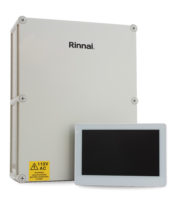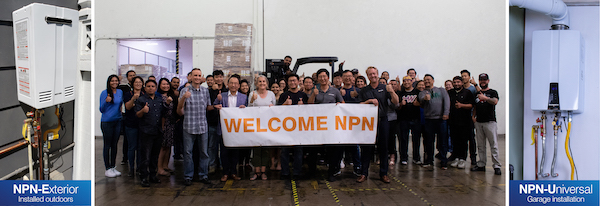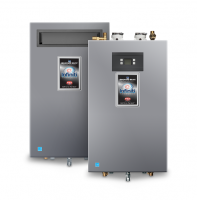Rinnai America Corp. announced the acquisition of Industrias MASS, the leader in the commercial water heater market in Mexico. This acquisition marks the first by Rinnai America Corporation and follows the launch of its Strategic Business Initiative announced earlier this year, meant to accelerate the company’s presence via acquisitions and partnerships Read more
tankless
Rinnai America Corp. announced the acquisition of Industrias MASS, the leader in the commercial water heater market in Mexico. This acquisition marks the first by Rinnai America Corporation and follows the launch of its Strategic Business Initiative announced earlier this year, meant to accelerate the company’s presence via acquisitions and partnerships.

As plumbers, we tend to think of our industry as being somehow separate from mainstream technology. But the truth is that water transit technology is getting better all the time. Yes – the changes are a little slower than in the electronics world. But they are occurring. And they’re bringing big benefits. Plumbing technology is: Read more
As plumbers, we tend to think of our industry as being somehow separate from mainstream technology. But the truth is that water transit technology is getting better all the time.
Yes – the changes are a little slower than in the electronics world. But they are occurring. And they’re bringing big benefits.
Plumbing technology is:
- Making homes more efficient
- Reducing the number of leaks
- Improving the purity of water
- Making problems easier to fix and diagnoses
- Making installations less time-consuming
- Reducing water usage
- Making tanks redundant
- Allowing for touchless faucets and toilets
In this post, we take a look at some of the most talked-about plumbing technology to hit the market in recent years and the effect it is having on people’s lives.
Let’s get started.
Smart Irrigation
Google searches for the term “smart irrigation” are exploding at the moment. And it’s not hard to understand why. People don’t want to have to manage their gardens or crops’ hydration levels manually. Instead, they want to put the system on autopilot so that they can avoid drudgery.
The way smart irrigation works is pretty simple. You start by running a bunch of sprinklers or water dispensers next to the plants you want to water and then hook the system up to the mains. You then connect the sprinkler control to an app that uses sensor data to figure out when it should be watering. It’s clever enough to know that it doesn’t need to water when it rains, but does during a drought.
Smart irrigation also allows customers to see precisely how much water they’re using for environmental reasons – currently a major concern.
Leak Detectors
Imagine if you were able to attach detectors to galvanized steel pipes that would automatically tell you if there was a leak. Homes and businesses would save billions every year.
Well, as many of you will know, this technology already exists. All you need to do is install a simple-looking detector on a pipe and then it will tell you whether there’s a leak or not.
Many smart home brands, such as Samsung and Nest, already have leak detectors in their product lineup. Given the potential environmental benefits, we are probably going to see these installed as standard in the near future.
Touchless Technology
Traditional mechanical plumbing systems required people to physically turn handles and push knobs. But given the coronavirus, and germs in general, that old arrangement is not ideal, especially in public bathrooms.
Touchless technology, however, provides a way around this predicament. It works using a motion sensor. People place their hands in front of it and it changes the light signal, tripping a circuit which then mechanically activates the device. For toilets, users simply place their hands close to a sensor, and the thing flushes.
For plumbers, these new setups complicate matters somewhat. You need to understand both plumbing and electronics to service this equipment. But, as of right now, the writing’s on the wall. This is where the industry is heading.
Greywater Recycling Systems
Greywater recycling systems are another eco-friendly innovation people want to learn more about. Homes and businesses want to be able to recycle water from dirty dishes and use it for other purposes, such as irrigation.
Brands offering greywater systems are coming online all the time. But there’s an information problem: currently, the vast bulk of regular consumers don’t even know these systems exist.
That will likely change in the coming years. Consumers want to save water. And greywater recycling systems aren’t particularly complicated. They let people save on their overall water bill while also potentially providing their plants with additional nourishment.
Smart Showers
Traditional showers involved a lot of careful calibration to get the temperature just right. Users often had to adjust dials by minuscule amounts, otherwise, it would be too hot or too cold. Repeating their experience in other places, such as hotels, was impossible.
Smart showers hope to put an end to this. Instead of presenting the user with a dial, these feature a touchscreen control panel that allows direct temperature selection. So if somebody knows that they enjoy showers at 42 C, then they can simply choose this temperature and start washing.
Smart showers are still a luxury item, but that won’t last. Just like prices for other electronics, the cost of these systems is coming down all the time. And the market is growing too. So many people want to purchase them.
Tankless Water Heaters
Tankless water heaters are currently a bit of an obsession among the home-owning community. Everybody seems to be interested in them right now.
Tankless water heaters are popular because they offer space-saving. Without a tank, you can potentially fit more living space into a given footprint.
Consumers also love tankless water heaters because they provide a continual stream of hot water. So long as the element is active, a warm shower never needs to come to an end.
The primary driving force behind this trend appears to be convenience. People don’t want to spend money on maintaining clunky tanks. They want something simple and durable.
They also want energy-efficient solutions. Homeowners feel uncomfortable about keeping water hot all the time. They’d prefer to simply heat it when they need it.
Linked to tankless water heaters is the technology of hot water circulation. The idea here is to eliminate the problem of cold water sitting in pipes. Usually, you would first have to run a shower or faucet to eliminate the cold water before the hot water came through.
But with hot water circulation, you simply apply low heat to the small amount of water in the pipes and use a pump to circulate it around. Then, when the time comes to use it, hot water comes out immediately.
So, in summary, the world of plumbing is not standing still. Technology is advancing all the time, and it’s making people’s lives better. What’s interesting is how much of this technology saves water and makes systems more reliable. Homes and businesses could very well face much lower prices in the future.

The Rinnai® BMS Gateway creates a unique solution for hot water management Having a way to control and monitor hot water usage creates efficiencies for business leaders and facility managers but is often critical to keeping businesses’ doors open. That’s why Rinnai has launched the Building Management System (BMS) Gateway, a new product that will provide commercial Read more
The Rinnai® BMS Gateway creates a unique solution for hot water management
Having a way to control and monitor hot water usage creates efficiencies for business leaders and facility managers but is often critical to keeping businesses’ doors open. That’s why Rinnai has launched the Building Management System (BMS) Gateway, a new product that will provide commercial and vertical markets a software system used to remotely control and monitor Rinnai Commercial Tankless Water Heaters.
“Our brand promise is Creating a Healthier Way of Living® and we are focused on providing simple, affordable solutions for businesses,” said Frank Windsor, President of Rinnai North America. “The Rinnai BMS Gateway is the next step to empowering customers to actively manage hot water and help it run seamlessly through any building.”
Whether using the optional Touch Screen User Interface that acts as an enhanced controller or working directly through the BMS Gateway, businesses can remotely turn tankless water heaters on or off, adjust water temperature, monitor flow rates, operation hours and more. The BMS Gateway and Touch Screen User Interface also allows up to 15 view-only parameters such as water flow rates, combustion cycles, operation hours and error code history.
Businesses can pair up to six Rinnai Commercial Condensing Water Heaters per BMS Gateway, with up to four gateways per network, for a maximum of 24 tankless units connected thereby enabling greater reach. Additionally, the BMS Gateway works with Rinnai CU199 and CU160 condensing tankless models and uses BACnet, Modbus or LonWorks communication protocols.
“Many commercial settings, such as school campuses, healthcare facilities, multifamily and government buildings, are often required to have BMS capabilities,” said Dale Schmitz, Rinnai Marketing Segment Manager. “We are now able to provide customers with an intuitive gateway to remotely control and monitor Rinnai Commercial Tankless Water Heaters through a customer-supplied BMS system.”
Businesses can upgrade their tankless water heaters to include the BMS Gateway or install a whole new system and save thousands in acquisition, maintenance and energy costs. Rinnai tankless units offer precise load tracking, so the amount of energy consumed is directly correlated to the amount of water heated at any given time versus having to heat and re-heat stored water with boilers and tanks.
The Rinnai Tankless Rack System comes in Wall-hanging or Freestanding configurations, includes factory assembled manifolds for gas and water that are tested and warrantied, provides built-in redundancy and can be combined with up to 24 units to provide 4.8 million Btu.
Rinnai is here to solve the needs of businesses while also providing easy, affordable turnkey solutions. With the latest and greatest addition of the BMS Gateway, Rinnai is here to keep hot water running for businesses to stay in business.
To learn more about Rinnai, visit www.rinnai.us.
Irvine, Calif. — Navien’s new premium non-condensing (NPN) tankless water heaters are being installed almost as quickly as they are shipped. Currently available in a universal indoor/outdoor model (NPN-Universal) in sizes 180,000 BTU/H and 199,900 BTU/H or an exterior, outdoor only model (NPN-Exterior) in sizes 180,000 BTU/H and 199,900 BTU/H. The NPN is available for order Read more
Irvine, Calif. — Navien’s new premium non-condensing (NPN) tankless water heaters are being installed almost as quickly as they are shipped. Currently available in a universal indoor/outdoor model (NPN-Universal) in sizes 180,000 BTU/H and 199,900 BTU/H or an exterior, outdoor only model (NPN-Exterior) in sizes 180,000 BTU/H and 199,900 BTU/H. The NPN is available for order now.

To learn more about NPN series non-condensing tankless water heaters, visit Navieninc.com.

The Smarter Way to Go Tankless The Infiniti™ K Series of tankless water heaters is the smarter way to go tankless. The Infiniti K uses STEADISET™ Technology to keep water temperature consistent and virtually eliminate “cold water sandwich” with NO internal buffer tank. It features SRT™ Scale Reduction Technology for better performance, longer operational life Read more
 The Smarter Way to Go Tankless
The Smarter Way to Go Tankless
The Infiniti™ K Series of tankless water heaters is the smarter way to go tankless. The Infiniti K uses STEADISET™ Technology to keep water temperature consistent and virtually eliminate “cold water sandwich” with NO internal buffer tank. It features SRT™ Scale Reduction Technology for better performance, longer operational life, and lower maintenance costs versus conventional tankless. The series delivers efficiency up to .96 UEF, which helps maximize the financial benefits of choosing tankless.
Features include:
- Exceptional Temperature Stability.STEADISET™ Technology keeps the temperature consistent with NO internal buffer tank.
- Best-In-Class Venting Lengths. Vent with either 2” or 3” PVC or polypropylene.
- Best-In-Class Scale Reduction. SRT™ Scale Reduction Technology delivers improved performance, longer life and lower maintenance costs.
- Best-In-Class Modulation. 22:1 turndown.
- Best-In-Class Warranty.15 years (heat exchanger).
- Efficient Performance – Even at Low Flow Rates. Activates at just 0.45gpm.
- Easy Installation. Top connections and built-in flush ports reduce time and cost of installation. No combustion analyzer needed.
- Contractor-Friendly Design for Easy Field Maintenance – Built for the contractor to give you room to work.
https://youtu.be/aOrKiM5VhfE
For more information visit Bradford White Infiniti™ K Series.

 The Smarter Way to Go Tankless
The Smarter Way to Go Tankless